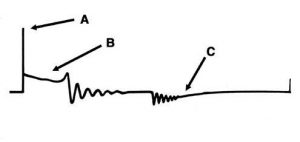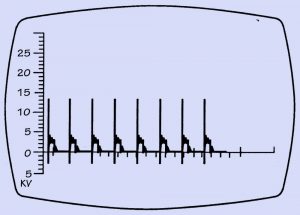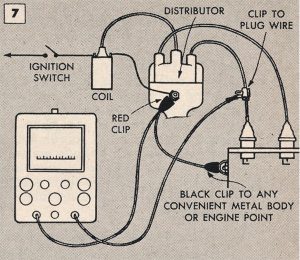Guest mechanic this month started with an article from Ken Barber and finished by Wheel Tracks
 When an oscilloscope is used by a mechanic to tune your engine, the picture to the left is what one good cylinder looks like during one firing cycle.
When an oscilloscope is used by a mechanic to tune your engine, the picture to the left is what one good cylinder looks like during one firing cycle.
An oscilloscope allows you to see the voltage pattern of anything that uses voltage. They were first developed in 1932 and can be great for tuning your old car, even if your car is a 1901 vehicle.
The pattern to the left tells you how well your equipment is working, that produces the spark that explodes the fuel in your cylinders, that gives you car the power to drive down the road.
A…. Indicates the level of voltage the coil produces to make the spark at your plug. That little flat part just below and to the left of ’A’ is the moment your points close.
B…. Is called the “Spark Line” where if working properly as in this picture, should decrease in a smooth action to zero. The little wiggles to the right of ’B’ is the final remnants of the spark being absorbed by your condenser. When this does not happen, people radios and tvs get lots of interference, plus your engine can not be properly ready to begin its next firing cycle.
D… This show when the points close to allow voltage back to your coil and be ready to make the next 25,000 volt spark. That little oscillation between D and C is normal and show the voltage settling down while your coil initially starts it’s recharge.
The distance between D and E is called Dwell and is simply the time adjustment for your points to be closed allowing voltage to your coil.
The distance between A and E is simply a time period that one cylinder needs during one cycle. During that one cycle, four things happen.
- The gas and air mixture explodes from the spark at the plug.
- The exhaust is pushed out the exhaust pipe.
- The next mixture of gas and air is pulled into the cylinder.
- Then it is all compressed to be ready for the next big spark.
 The picture on the left shows an 8 cylinder engine, all cylinders doing what they are supposed to be doing with the spark plugs firing with 14,000 volts. If a mechanic sees the 3rd vertical lines at, say, 5,000 volts, then he might pull the spark plug from #3 cylinder to see if it is defective.
The picture on the left shows an 8 cylinder engine, all cylinders doing what they are supposed to be doing with the spark plugs firing with 14,000 volts. If a mechanic sees the 3rd vertical lines at, say, 5,000 volts, then he might pull the spark plug from #3 cylinder to see if it is defective.
If the little condenser oscillation is not there like we can see between B and D above, the mechanic can suspect a bad condenser.
On the right is a normal set-up for connecting a scope to your engine.
Scopes are inexpensive these days and you should not let yourself get duped into thinking this is complicated… it is not. The more you use it and the more you see the patterns, the easier it is to find problems and make your engine run as smooth as possible.
A scope can even be used in one-lungers, so hit Napas and ask some questions.



Leave a Reply